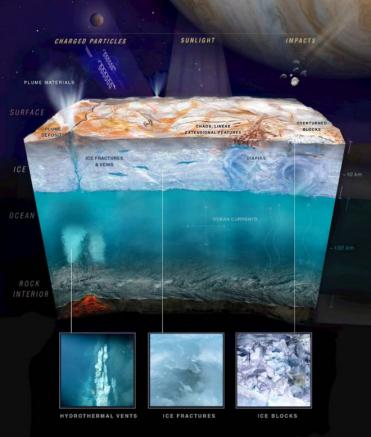Passage
LIFE ON EUROPA
Orbiting the giant planet Jupiter, is an icy world named Europa, just a little smaller than Earth's moon. From a distance, Europa appears to be etched with a nexus of dark streaks. Close up, these are revealed to be long linear cracks in the ice, many of which are filled with an unknown contaminant. Elsewhere, the surface is irregular, as if massive slabs of ice have drifted, spun and flipped over. Jupiter's immense gravity helps generate tidal forces that repeatedly stretch and relax the terrain of the moon Europa. But the stresses that created Europa's terrain are best explained by the ice shell floating on an ocean of liquid water. The fact that there's liquid water underneath the surface which we also know from the magnetometer observations made by the Galileo spacecraft, makes it one of the most exciting potential targets to look for life. Europa's dark, briny deep might extend up to 110 km into the moon's interior, meaning it could be holding twice as much liquid water as there is in all of Earth's oceans. And while water is one vital prerequisite for life, Europa's ocean might have others - such as a source of chemical energy for microbes.
However, the ice shell that surrounds the ocean is thought to be tens of kilometers thick. On the face of it, this might make any notions of exploring Europa's watery depths seem impossible. Luckily, scientists think there are a number of ways for the ocean to communicate with the surface. For example, the physical process of heat transfer known as convection may cause warm blobs of ice located deep within the shell to travel upwards to the surface. So studying the moon's outer face could provide clues to what is happening far beneath it.
Scientists are trying to get at Europa's potential habitability, the ingredients for life: water, and whether there's chemical energy for life. They do that by trying to understand the ocean and the ice shell, the composition and the geology, and mixed into those is the level of current activity at Europa. In Europa's rocky interior, heat is probably generated by tidal forces and by the decay of radioactive isotopes. Scientists think the heating may drive volcanic vents on the seafloor - an important point in favor of the moon's habitability, since terrestrial vent systems support a wide array of life forms.
Europa's orbital path takes it deep into Jupiter's powerful magnetic field, which traps and speeds up particles. The resulting belts of intense radiation drives reactions on Europa's surface, yielding chemicals called oxidants. On Earth, biology exploits the chemical reactions between oxidants and compounds known as reductants to supply the energy needed for life. However, the oxidants made on the surface are only useful to Europan microbes if they can get down into the ocean. Fortunately, the process of convection that pushes warm blobs of ice upwards might also drive surface material down. Once in the ocean, oxidants could react with reductants made by seawater interacting with the rocky ocean floor.
NASA is planning a mission, named Clipper, to collect signs of life on Europa. Clipper carries a payload of nine sensitive instruments, including a camera that will image most of the surface; spectrometers to understand its composition; ice-penetrating radar to map the ice shell in three dimensions and find water beneath the ice shell; and a magnetometer to characterize the ocean. The strength of sunlight near Europa is about a 30th of what it is at Earth, but in spite of that, NASA wants to power Clipper with solar panels rather than the radioactive generators some other outer planet missions have used.

A couple of innovative Europa Lander concept have been proposed, one being a projectile deployed from a satellite hits the surface "really hard, at about 300m/second, or about 700 miles an hour," exposing pristine ice for analysis by onboard instruments, which could be designed to withstand the impact. By contrast, a Lander would put down Clipper softly on Europa and during the touchdown, it will use an autonomous landing system to detect and avoid surface hazards in real time. The landing site should be such that there might be water close to the surface. The Lander is all about hitting the freshest, most pristine sample possible. One way to do that is to dig deep; another way is going to where there is some kind of eruption on the surface that drops very fresh material onto the surface. The Hubble telescope in the past had made tentative observations of geysers where plumes of water-ice erupt from beneath Europa. So, scientists need to understand why the geysers are formed.
Adapted from the article: www.bbc.com/news/science-environment-38925601